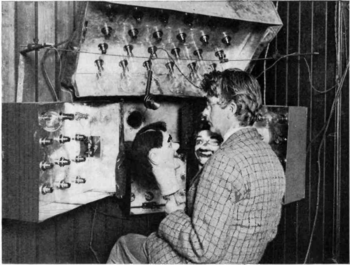

Stooky Bill was the name given to the head of a ventriloquist's dummy that Scottish television pioneer John Logie Baird used in his 1924 experiments to transmit a televised image between rooms in his laboratory at 22 Frith Street, London.
YouTube Encyclopedic
-
1/3Views:669 82558 46614 172
-
Televisor 3 - Mechanical Television
-
Oldest Television Broadcast Mystery
-
John Logie Baird: The Man Who Invented Television
Transcription
History
John Logie Baird invented some of the first experimental television systems. In 1924 he developed a mechanical television system to transmit moving images by means of electrical signals, which he demonstrated on 25 March 1925 at a London department store, Selfridges. It consisted of a spinning disk set with a spiral pattern of 30 lenses. As each lens rotated past the illuminated subject, it focused the light from a spot on the subject on a photoelectric cell. This converted the brightness of the image at each spot into a proportional electric signal, which could be sent to a receiver by radio waves. As each lens swept past the subject, it scanned a successive line of the image. At the receiver, a light shining through the holes in a similar rotating disk recreated an image of the subject.
Due to the low sensitivity of the photoelectric cells, Baird's first system was not able to televise human faces, because they had inadequate contrast. Baird therefore used a ventriloquist's dummy, the brightly painted face of which had greater contrast, and made it move and talk before the scanner. The incandescent lights illuminating the subject to be televised also generated so much heat that Baird could not use a human for the testing. Eventually the hair became singed and the painted face became cracked by the heat. Stooky Bill and another Baird dummy, "James", have been jokingly called "the first television actors".
Stooky Bill is now on display at the Science and Media Museum in Bradford, England.
Name
"Stooky" or "stookie" is Scots for stucco or plaster of Paris, or for a plaster cast used to immobilise bone fractures.[1] The term is also used for someone who is slow-witted or awkward in their movements.
In popular culture
Stooky Bill was a major plot point in the Doctor Who 60th anniversary special "The Giggle", in which he was used by the villainous Toymaker to spread insanity through every screen on Earth.[2]
See also
References
- ^ Robinson, Mairi (1987). The Concise Scots Dictionary. Aberdeen University Press. pp. 673–4. ISBN 0-08-028492-2.
- ^ Jeffery, Morgan (9 December 2023). "Doctor Who: The Giggle true story – was Stooky Bill real?". Radio Times.
External links
- David Hall's video art piece Stooky Bill TV, for Channel 4 TV 1990
- John Logie Baird's test subject 'Stookie Bill', Science Museum Group Collection
- John Burnside; Kirsty Wark; Alistair McGowan The Ballad of Stooky Bill; BBC Radio 4
